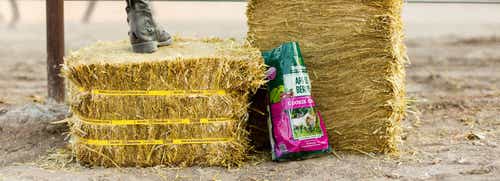
4 Tips for Managing and Feeding Goats in the Fall
Just like people, fall is a transition period for goats. This is the time to prepare their bodies for winter weather and the breeding season, and make adjustments to their diet as needed with good quality forage.
We would like to provide you with some tips for managing your goat herd as the leaves change and air cools off.
1. Body Condition
When feeding goats in fall, use the time post-weaning of goat kids to adjust the Body Condition of does. You can reduce their diet from alfalfa hay-based diet to grass hay. If good pasture isn't available, dry grass forage of a horse quality is acceptable and can be fed free choice or twice a day. Goats require long stem fiber (roughage) for proper rumen function. The long fiber lengths of pasture, hay and browse are necessary for rumen function. The rumen is rich in live bacteria that begins to digest the fiber.
2. Preparation for Breeding
Prepare your doe for breeding by increasing nutritional plane to flush additional eggs for breeding. The flushing process increases the likelihood of twin kids rather than single kids. When increasing calories for their diet, care should be taken when selecting and feeding grain. This should start 2-3 weeks prior to introducing the buck or artificial insemination.
3. Health and Maintenance
The fall is a great time prior to breeding to worm and vaccinate the goats - medications and drugs to utilize will depend on local conditions and veterinary recommendations. Be sure to follow local recommendations for worming and vaccination to ensure your animals remain healthy.
4. Focus on Feet
Prior to breeding, check and trim feet. Goat hooves tend to grow more rapidly than sheep and prior to pregnancy is a great time to conduct foot maintenance.
When feeding your goats, each goat requires 2 – 4 pounds of forage per day (3-4% of body weight in pounds). Because goats are ruminant, avoid making drastic changes to their diet. Instead, make a slow transition to allow the bacteria in their rumen time to adjust. Make sure that your goats also have access to clean water. If you have questions, please contact the nutritionists at Standlee, or consult with your veterinarian.
To learn more about goat nutrition, listen to episode 36 of our Beyond the Barn podcast with Dr. Cubitt and Katy Starr as they interview Extension Educator, Carmen Willmore.












